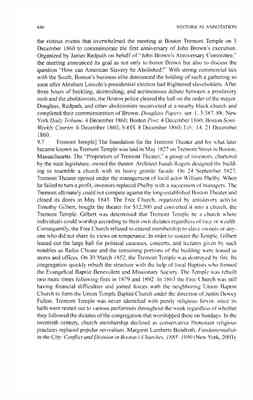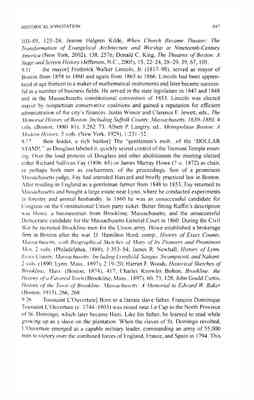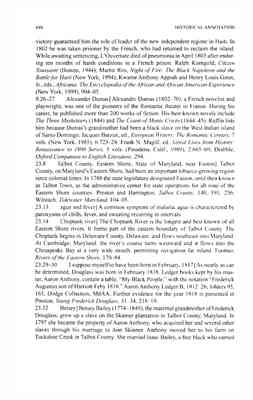Pages
16
644 HISTORICAL ANNOTATION
of sexton, steward, class leader, clerk, and local preacher, as among the happiest days of my life." James W. Hood, One Hundred Years of the African Methodist Episcopal Zion Church (New York, 1895), 541-42; Douglass Papers, ser. 2, 2:203; Blight, Frederick Douglass' Civil War, 6-10; William L. Andrews, "Frederick Douglass, Preacher," American Literature, 54:592-97 (December 1982). 7.27-28 He became a member...American Anti-Slavery society] Inspired by the success of the British emancipation movement, a group of sixty-two American abolitionists, including Quakers, free blacks, New York evangelicals, and New England radicals such as William Lloyd Garrison, met in Philadelphia in December 1833 and founded the American Anti-Slavery Society. Garrison drafted most of the society's original Declaration of Sentiments, which endorsed a blend of immediatist principles and moral suasion tactics. By the time Douglass became a lecturer for the American Anti-Slavery Society in the early 1840s, the organization had suffered a serious schism when many abolitionists had quit in protest at Garrison's stands on women's rights, religious orthodoxy, and an independent antislavery political party. Merton L. Dillon, The Abolitionists: The Growth of a Dissenting Minority (DeKalb, Ill., 1974). 52-53, 113-26; James Brewer Stewart, Holy Warriors: The Abolitionists and American Slavery (New York, 1976), 51-52, 92-96. 7.38 England, Ireland, and Scotland] In 1845 Douglass embarked upon an antislavery tour of the British Isles, landing in Liverpool, England, on 28 August. After numerous successful speaking engagements, meeting some of the greatest abolitionists and politicians in Great Britain, and having his freedom purchased by British acquaintances, Douglass returned to the United States. His ship made landfall on 20 April 1847. Lib., 26 September 1845, 23, 30 April 1847; Alan J. Rice and Martin Crawford, eds., Liberating Sojourn: Frederick Douglass and Transatlantic Reform (Athens, Ga., 1999), 1-11. 8.8-9 that colored people...high intellectual position] Nineteenth-century arguments supporting the intellectual inferiority of blacks proceeded along three interconnected axes: scientific, aesthetic, and biblical. The ethnological conclusions of Josiah Clark Nott, George Robert Gliddon, Jean Louis Rodolphe Agassiz, and Samuel George Morton collectively formed the doctrines of what came to be known as the American School of Ethnology. These ethnologists posited a polygenist theory of racial origin, claiming that each race was a distinct species, based on what they considered empirical evidence of fixed intellectual inferiority. Morton's measurements of cranial capacity provided the bulk of this evidence, although Morton himself opposed slavery and believed that intellectual growth of blacks was impossible because of the hostile social environment in which they lived rather than because of heredity. Most ethnological treatises included a chapter on beauty, connecting a racist aesthetic to both moral and intellectual development. Conversely, white proslavery Christians in the South argued against polygenesis, classifying blacks as inferior members of the same species. They claimed that scripture provided a defense of slavery and that the mission of that institution was to Christianize those of African descent. Some clergymen
17
HISTORICAL ANNOTATION 645
justified enslaving dark-skinned races on a misinterpretation of Noah's curse on Ham. While most southern Christians did not believe that intellectual growth was impossible for slaves, they envisioned such progress as occurring slowly and in minuscule increments barely noticeable over the course of centuries. George M. Fredrickson, The Black Image in the White Mind: The Debate on Afro-American Destiny, 1817-1914 (New York, 1971), 43-96; David M. Goldenberg, The Curse of Ham: Race and Slavery in Early Judaism, Christianity, and Islam (Princeton, N.J., 2003), 167; Reginald Horsman, Race and Manifest Destiny: The Origins of American Racial Anglo-Saxonism (Cambridge, Mass., 1981), 116-57; William Stanton, The Leopard's Spots: Scientific Attitudes toward Race in America, 1815-59 (Chicago, 1960), 92-97, 100; Christopher A. Luse, "Slavery's Champions Stood at Odds: Polygenesis and the Defense of Slavery," CWH, 53:379-412 (December 2007); Arthur Riss, "The Art of Discrimination," English Literary History, 71:251-87 (Spring 2004). 8.14-15 His encounter with the overseer of the eastern shore plantation] An allusion to Douglass's audacious fight with the Maryland yeoman farmer Edward Covey (c. 1806-75), who had been given oversight of Douglass by Thomas Auld for the year 1834. Covey started out as a farm-renter in Talbot County, Maryland, but managed to accumulate $23,000 in real estate by 1850. Covey's reputation as a slave breaker enabled him to rent or even to receive the free use of field hands from local slave owners anxious to have their slaves taught proper discipline. Harriet Lucretia Anthony, the great-granddaughter of Aaron Anthony, remembered that "Mr. Covey was really noted for his cruelty and meanness." Inventory of the Estate of Edward Covey, 15 May 1875, Talbot County Inventories, TNC#3, 578, MdTCH; Harriet L. Anthony, annotated copy of Bondage and Freedom, folders 93, 203, Dodge Collection, MdAA; 1850 U.S. Census, Maryland, Talbot County, 240 (free schedule); Preston, Young Frederick Douglass, 117-31. 8. 16 unwritten rule of law] According to Maryland law, death was the punishment for any slave who refused to surrender himself or herself or resisted apprehension. The code actually permitted the pursuer of a resisting slave to "shoot, kill, and destroy such negro or negroes." The General Public Statutory Law and Public Local Law of the State of Maryland From the Year 1692 to 1839, 3 vols. (Baltimore, 1840), 1:65. 8.18-19 plotting with other...giving them passes] In 1836 Douglass and five other slaves plotted to escape via a stolen ship from Talbot County, Maryland, to the North. Douglass recounts this failed effort in chapter 19 of this autobiography. 8.19-20 the unequal...ship yard] Douglass was apprenticed as a ship's caulker in William Gardner's Baltimore shipyard in 1836. The attack on Douglass by white shipyard workers at Gardner's wharf occurred approximately eight months after he began employment there and is described in chapter 20 of this autobiography. McFeely, Frederick Douglass, 58-63. 9.7 John Brown meeting] Newspaper reports vary significantly on the details of
18
646 HISTORICAL ANNOTATION
the riotous events that overwhelmed the meeting at Boston Tremont Temple on 3 December 1860 to commemorate the first anniversary of John Brown's execution. Organized by James Redpath on behalf of "John Brown's Anniversary Committee," the meeting announced its goal as not only to honor Brown but also to discuss the question "How can American Slavery be Abolished?" With strong commercial ties with the South, Boston's business elite denounced the holding of such a gathering so soon after Abraham Lincoln's presidential election had frightened slaveholders. After three hours of heckling, skirmishing, and acrimonious debate between a proslavery mob and the abolitionists, the Boston police cleared the hall on the order of the mayor. Douglass, Redpath, and other abolitionists reconvened at a nearby black church and completed their commemoration of Brown. Douglass Papers, ser. 1, 3:387-88; New York Daily Tribune, 4 December 1860; Boston Post, 4 December 1860; Boston SemiWeekly Courier, 6 December 1860; NASS, 8 December 1860; Lib., 14, 21 December 1860. 9.7 Tremont Temple] The foundation for the Tremont Theater and for what later became known as Tremont Temple was laid in May 1827 on Tremont Street in Boston, Massachusetts. The "Proprietors of Tremont Theater," a group of investors, chartered by the state legislature, owned the theater. Architect Isaiah Rogers designed the building to resemble a church with its heavy granite facade. On 24 September 1827, Tremont Theater opened under the management of local actor William Phelby. When he failed to turn a profit, investors replaced Phelby with a succession of managers. The Tremont ultimately could not compete against the long-established Boston Theater and closed its doors in May 1843. The Free Church, organized by antislavery activist Timothy Gilbert, bought the theater for $12,500 and converted it into a church, the Tremont Temple. Gilbert was determined that Tremont Temple be a church where individuals could worship according to their own dictates regardless of race or wealth. Consequently, the Free Church refused to extend membership to slave owners or anyone who did not share its views on temperance. In order to sustain the Temple, Gilbert leased out the large hall for political caucuses, concerts, and lectures given by such notables as Rufus Choate and the remaining portions of the building were leased as stores and offices. On 30 March 1852, the Tremont Temple was destroyed by fire. Its congregation quickly rebuilt the structure with the help of local Baptists who formed the Evangelical Baptist Benevolent and Missionary Society. The Temple was rebuilt two more times following fires in 1879 and 1892. In 1863 the Free Church was still having financial difficulties and joined forces with the neighboring Union Baptist Church to form the Union Temple Baptist Church under the direction of Justin Dewey Fulton. Tremont Temple was never identified with purely religious fervor, since its halls were rented out to various performers throughout the week regardless of whether they followed the dictates of the congregation that worshipped there on Sundays. In the twentieth century, church membership declined as conservative Protestant religious practices replaced popular revivalism. Margaret Lamberts Bendroth, Fundamentalists in the City: Conflict and Division in Boston's Churches, 1885-1950 (New York, 2003),
19
HISTORICAL ANNOTATION 647
103-05, 123-24; Jeanne Halgren KiIde, When Church Became Theater: The Transformation of Evangelical Architecture and Worship in Nineteenth-Century America (New York, 2002), 138, 257n; Donald C. King, The Theatres of Boston: A Stage and Screen History (Jefferson, N.C., 2005), 15, 22-24, 28-29, 39, 67, 105. 9.11 the mayor] Frederick Walker Lincoln, Jr. ( 1817-98), served as mayor of Boston from 1858 to 1860 and again from 1863 to 1866. Lincoln had been apprenticed at age thirteen to a maker of mathematical instruments and later became successful in a number of business fields. He served in the state legislature in 1847 and 1848 and in the Massachusetts constitutional convention of 1853. Lincoln was elected mayor by nonpartisan conservative coalitions and gained a reputation for efficient administration of the city's finances. Justin Winsor and Clarence F. Jewett, eds., The Memorial History of Boston, Including Suffolk County, Massachusetts, 1630-1880, 4 vols. (Boston, 1880-81), 3:262-73; Albert P. Langtry, ed., Metropolitan Boston: A Modern History, 5 vols. (New York, 1929), 1:231-32. 9.17 their leader, a rich banker] The "gentlemen's mob...of the 'DOLLAR STAMP,"'as Douglass labeled it, quickly seized control of the Tremont Temple meeting. Over the loud protests of Douglass and other abolitionists the meeting elected either Richard Sullivan Fay (1806-65) or James Murray Howe (?-c. 1872) as chair, or perhaps both men as cochairmen, of the proceedings. Son of a prominent Massachusetts Judge, Fay had attended Harvard and briefly practiced law in Boston. After residing in England as a gentleman farmer from 1848 to 1853, Fay returned to Massachusetts and bought a large estate near Lynn, where he conducted experiments in forestry and animal husbandry. In 1860 he was an unsuccessful candidate for Congress on the Constitutional Union party ticket. Better fitting Ruffin 's description was Howe, a businessman from Brookline, Massachusetts, and the unsuccessful Democratic candidate for the Massachusetts General Court in 1860. During the Civil War he recruited Brookline men for the Union army. Howe established a brokerage firm in Boston after the war. D. Hamilton Hurd, comp., History of Essex County, Massachusetts, with Biographical Sketches of Many of Its Pioneers and Prominent Men, 2 vols. (Philadelphia, 1888), 1:353-54; James R. Newhall, History of Lynn, Essex County, Massachusetts: Including Lynnfield, Saugus, Swampscott, and Nahant, 2 vols. (1890; Lynn, Mass., 1897), 2:19- 20; Harriet F. Woods, Historical Sketches of Brookline, Mass. (Boston, 1874), 417; Charles Knowles Bolton, Brookline: the History of a Favored Town (Brookline, Mass., 1897), 60, 73, 128; John Gould Curtis, History of the Town of Brookline, Massachusetts: A Memorial to Edward W. Baker (Boston, 1933), 266, 268. 9.26 Toussaint L'Ouverture] Born to a literate slave father, François Dominique Toussaint L'Ouverture (c. 1744-1803) was raised near Le Cap in the North Province of St. Domingo, which later became Haiti. Like his father, he learned to read while growing up as a slave on the plantation. When the slaves of St. Domingo revolted, L'Ouverture emerged as a capable military leader, commanding an army of 55,000 men to victory over the combined forces of England, France, and Spain in 1794. This
20
648 HISTORICAL ANNOTATION
victory guaranteed him the role of leader of the new independent regime in Haiti. In 1802 he was taken prisoner by the French, who had returned to reclaim the island. While awaiting sentencing, L'Ouverture died of pneumonia in April 1803 after enduring ten months of harsh conditions in a French prison. Ralph Korngold, Citizen Toussaint (Boston, 1944); Martin Ros, Night of Fire: The Black Napoleon and the Battle for Haiti (New York, 1994); Kwame Anthony Appiah and Henry Louis Gates, Jr., eds., Africana: The Encyclopedia of the African and African American Experience (New York, 1999), 904-05. 9.26-27 Alexander Dumas] Alexandre Dumas (1802-70), a French novelist and playwright, was one of the pioneers of the Romantic theater in France. During his career, he published more than 200 works of fiction. His best-known novels include The Three Musketeers (1844) and The Count of Monte Cristo (1844-45). Rullin lists him because Dumas's grandmother had been a black slave on the West Indian island of Santo Domingo. Jacques Barzun, ed., European Writers: The Romantic Century, 7 vols. (New York, 1985), 6:723-24; Frank N. Magill, ed., Great Lives from History: Renaissance to 1900 Series, 5 vols. (Pasadena, Calif., 1989), 2:665-69); Drabble, Oxford Companion to English Literature, 294. 23 .8 Talbot County, Eastern Shore, State of Maryland, near Easton] Talbot County, on Maryland's Eastern Shore, had been an important tobacco-growing region since colonial times. In 1788 the state legislature designated Easton, until then known as Talbot Town, as the administrative center for state operations for all nine of the Eastern Shore counties. Preston and Harrington, Talbot County, 140, 191, 256; Wilstach, Tidewater Maryland, 104-05. 23.13 ague and fever] A common symptom of malaria, ague is characterized by paroxysms of chills, fever, and sweating recurring in intervals. 23.14 Choptank river] The Choptank River is the longest and best known of all Eastern Shore rivers. It forms part of the eastern boundary of Talbot County. The Choptank begins in Delaware County, Delaware, and flows southeast into Maryland. At Cambridge, Maryland, the river's course turns westward and it flows into the Chesapeake Bay at a very wide mouth, permitting navigation far inland. Footner, Rivers of the Eastern Shore, 170-84. 23.29- 30 I suppose myself to have been born in February, 1817] As nearly as can be determined, Douglass was born in February 1818. Ledger books kept by his master, Aaron Anthony, contain a table, "My Black People," with the notation "Frederick Augustus son of Harriott Feby 1818." Aaron Anthony Ledger B. 1812-26, folders 95, 165, Dodge Collection, MdAA; Further evidence for the year 1818 is presented in Preston, Young Frederick Douglass, 31-34, 218-19. 23.32 Betsey] Betsey Bailey (1774-1849), the maternal grandmother of Frederick Douglass, grew up a slave on the Skinner plantation in Talbot County, Maryland. In 1797 she became the property of Aaron Anthony, who acquired her and several other slaves through his marriage to Ann Skinner. Anthony moved her to his farm on Tuckahoe Creek in Talbot County. She married Isaac Bailey, a free black who earned




